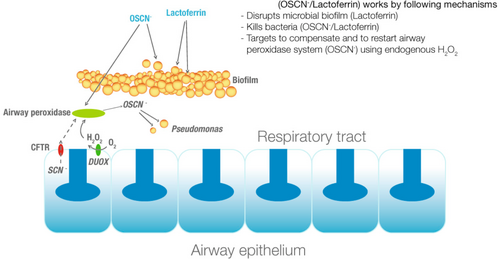Biology:Respiratory tract antimicrobial defense system
The respiratory tract antimicrobial defense system is a layered defense mechanism which relies on components of both the innate and adaptive immune systems to protect the lungs and the rest of the respiratory tract against inhaled microorganisms. In the first line of defense, inhaled bacteria are trapped by mucus and are swept toward the pharynx and are swallowed.[1] Bacteria which penetrate the mucous layer are dealt with a second line of defense which includes antimicrobial peptides that are secreted by the surface epithelium of the respiratory tract which kill many strains of bacteria.[2] Those bacteria that are resistant to antimicrobial peptides are killed by a variety of reactive oxygen species produced by phagocytes. In a third line of defense and as a last resort, persistent bacterial infections which escape the innate immune system are eliminated by the adaptive immune system.
Lactoferrin
Lactoferrin (LF) is a multifunctional protein which is an essential part of the respiratory tract antimicrobial defense system.[3] LF proteolysis produces the small peptides lactoferricin and kaliocin-1 both with antimicrobial activity.[4]
Reactive oxygen species, oxygenated compounds
Phagocytes possess a superoxide-producing NADPH oxidase enzyme complex.[5] Other cells in the respiratory tract also produce superoxide and hydrogen peroxide through the activity of dual oxidase 2 proteins, also known as Duox2.[6][7]
The superoxide generated by these enzymes complexes dismutates into hydrogen peroxide which in turn is used by myeloperoxidase to produce bactericidal hypochlorous acid.[8] In addition, the submucosal glands of the respiratory tract secrete myeloperoxidase and lactoperoxidase (LPO)[9] that catalyzes the oxidation of thiocyanate and detoxify hydrogen peroxide or ROS to the antimicrobial hypothiocyanite.[10][11]
The oxygenated compounds produced by the lactoperoxidase system does not attack DNA and is not mutagenic and is known to be safe.[12] Hypothiocyanite generated through this pathway displays broad spectrum bactericidal activity including potent antibacterial action on H. pylori.[13]
Cystic fibrosis
Thiocyanate secretion[14] in cystic fibrosis patients is decreased resulting in a reduced production of the antimicrobial hypothiocyanite and consequently contributes to the increased risk of airway infection.[15][16]
Therapeutic applications
Lactoferrin with hypothiocyanite for the treatment of cystic fibrosis has been granted orphan drug status by the EMEA[17] and the FDA.[18]
References
- ↑ Boucher RC (January 2003). "Regulation of airway surface liquid volume by human airway epithelia". Pflügers Arch. 445 (4): 495–8. doi:10.1007/s00424-002-0955-1. PMID 12548395.
- ↑ Ganz T (March 2002). "Antimicrobial polypeptides in host defense of the respiratory tract". J. Clin. Invest. 109 (6): 693–7. doi:10.1172/JCI15218. PMID 11901174.
- ↑ "Biological role of lactoferrin". Arch. Dis. Child. 67 (5): 657–61. May 1992. doi:10.1136/adc.67.5.657. PMID 1599309.
- ↑ "A review: the active peptide of lactoferrin". Acta Paediatr Jpn 36 (5): 585–91. October 1994. doi:10.1111/j.1442-200x.1994.tb03250.x. PMID 7825467.
- ↑ Nauseef WM (October 2004). "Assembly of the phagocyte NADPH oxidase". Histochem. Cell Biol. 122 (4): 277–91. doi:10.1007/s00418-004-0679-8. PMID 15293055.
- ↑ "Hypothiocyanite ion: detection of the antimicrobial agent in human saliva". J. Dent. Res. 59 (9): 1466–72. September 1980. doi:10.1177/00220345800590090201. PMID 6931123.
- ↑ "Lactoperoxidase, peroxide, thiocyanate antimicrobial system: correlation of sulfhydryl oxidation with antimicrobial action". Infect. Immun. 20 (2): 456–63. May 1978. doi:10.1128/IAI.20.2.456-463.1978. PMID 352945.
- ↑ Klebanoff SJ (May 2005). "Myeloperoxidase: friend and foe". J. Leukoc. Biol. 77 (5): 598–625. doi:10.1189/jlb.1204697. PMID 15689384.
- ↑ "Lactoperoxidase and human airway host defense". Am. J. Respir. Cell Mol. Biol. 29 (2): 206–12. August 2003. doi:10.1165/rcmb.2002-0152OC. PMID 12626341.
- ↑ "Lactoperoxidase and hydrogen peroxide metabolism in the airway". Am. J. Respir. Crit. Care Med. 166 (12 Pt 2): S57–61. December 2002. doi:10.1164/rccm.2206018. PMID 12471090.
- ↑ "The Lactoperoxidase System Links Anion Transport To Host Defense in Cystic Fibrosis". FEBS Lett. 581 (2): 271–8. January 2007. doi:10.1016/j.febslet.2006.12.025. PMID 17204267.
- ↑ "Peroxidase-Thiocyanate-Peroxide Antibacterial System Does Not Damage DNA". Antimicrob. Agents Chemother. 23 (2): 267–72. February 1983. doi:10.1128/aac.23.2.267. PMID 6340603.
- ↑ "Sensitivity of Helicobacter pylori to an innate defence mechanism, the lactoperoxidase system, in buffer and in human whole saliva". J. Med. Microbiol. 53 (Pt 9): 855–60. September 2004. doi:10.1099/jmm.0.45548-0. PMID 15314191.
- ↑ "The antioxidant role of thiocyanate in the pathogenesis of cystic fibrosis and other inflammation-related diseases". Proc. Natl. Acad. Sci. U.S.A. 106 (48): 20515–9. December 2009. doi:10.1073/pnas.0911412106. PMID 19918082.
- ↑ "A Novel Host Defense System of Airways Is Defective in Cystic Fibrosis". Am. J. Respir. Crit. Care Med. 175 (2): 174–83. January 2007. doi:10.1164/rccm.200607-1029OC. PMID 17082494.
- ↑ "Thiocyanate concentration in saliva of cystic fibrosis patients". Folia Histochem. Cytobiol. 46 (2): 245–6. 2008. doi:10.2478/v10042-008-0037-0. PMID 18519245.
- ↑ "Public summary of positive opinion for orphan designation of hypothiocyanite / lactoferrin for the treatment of cystic fibrosis". Pre-authorisation Evaluation of Medicines for Human Use. European Medicines Agency. 2009-09-07. http://www.ema.europa.eu/pdfs/human/comp/opinion/39298409en.pdf.
- ↑ "Meveol: orphan drug status granted by the FDA for the treatment of cystic fibrosis.". United States Food and Drug Administration. 2009-11-05. http://www.bioalaxia.eu/content/meveol-orphan-drug-status-granted-fda-treatment-cystic-fibrosis.
 |


